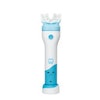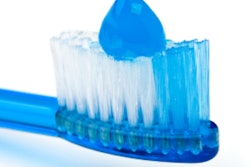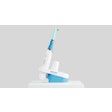
The U.K.'s National Health Service (NHS) could save money by implementing programs to prevent tooth decay. A study found that supervised toothbrushing and fluoride varnish programs for high-risk children could save hundreds of pounds per child, compared with the current cost of treatment.
The study was led by Elizabeth (Liz) Kay, BDS, MPH, PhD, and evaluated whether public health programs to reduce caries for the most deprived quintile of children could make economic sense for the U.K. The research was presented at the British Society for Oral and Dental Research (BSODR) annual meeting in September. Professor Kay is foundation dean of the Plymouth University Peninsula School of Dentistry.
“If dentistry and, in particular, preventive programs [are] to compete in the health marketplace for resources, these types of study are essential.”
"If dentistry and, in particular, preventive programs [are] to compete in the health marketplace for resources, these types of studies are essential," Professor Kay said in an interview with DrBicuspid.com. "We cannot show the value of oral health, or maintenance of dental health through repair, unless we begin to measure their impact using the same currency by which the importance of other diseases is assessed."
Coming up with the numbers
Nearly 26,000 children between the ages of 5 and 9 were admitted to hospitals in England for dental treatment in 2013-2014, according to a January 2015 report. In addition, the number of children being treated for largely preventable oral health diseases is rising.
To determine the cost-effectiveness of preventive oral health interventions for at-risk children, Professor Kay and additional researchers from the National Institute for Health and Care Excellence (NICE) and the York Health Economics Consortium developed an analytic model with five parameters:
- Baseline caries risk
- Caries risk reduction from an intervention
- Quality-adjusted life year (QALY) loss in each case of caries; QALY is a measure that incorporates both quantity and quality of life due to a medical intervention
- Cost of treatment
- Cost of intervention
The researchers used the model to compare the costs and benefits of no intervention versus providing fluoride varnish and supervised toothbrushing for 5- and 12-year-old children in the most deprived quintile. They obtained baseline caries risk information from national survey data and determined the treatments to be cost-effective if they corresponded with NICE's cost-effectiveness threshold of less than 20,000 pounds ($30,667 U.S.) per QALY.
| Cost-effectiveness of programs to prevent tooth decay in the U.K. | |||
| 5-year-olds with extractions under general anesthesia | Cost of treatment | Supervised toothbrushing | Fluoride varnish |
| High QALY loss | 225 pounds ($345) | Cost-effective at 46 pounds ($71) per child | Cost-effective at 62 pounds ($95) per child |
| Low QALY loss | 175 pounds ($268) | Cost-effective at 27 pounds ($41) per child | Cost-effective at 37 pounds ($57) per child |
For children at high risk for oral disease, supervised brushing and fluoride varnish programs could be cost-effective options, the model showed. Professor Kay and colleagues found that preventive programs for 5-year-olds are cost-effective even at 62 pounds ($95) per child for fluoride varnish and 46 pounds ($71) per child for supervised toothbrushing if all extractions were done under general anesthesia and QALY loss was high. If those same children's QALY loss were low, fluoride varnish would still be cost-effective at 37 pounds ($57) per child and supervised toothbrushing would be cost-effective at 27 pounds ($41) per child.
For 12-year-olds, the researchers found that if extractions are common and the interventions reduced caries risk by 39%, then preventive measures would be cost-effective at 81 pounds ($124) per child. However, if the interventions only reduced caries risk by 11%, the cost-effectiveness threshold would drop to 23 pounds ($35) per child, and if QALY loss and treatment costs for the 12-year-olds were both low, then spending more than 9 pounds ($14) per child on intervention treatments would not be cost-effective.
 Professor Kay, lead study author and foundation dean of Plymouth University Peninsula School of Dentistry. Image courtesy of Professor Kay and Lisa Allwood.
Professor Kay, lead study author and foundation dean of Plymouth University Peninsula School of Dentistry. Image courtesy of Professor Kay and Lisa Allwood.Putting the numbers to work
While some professional organizations in the U.K. and the U.S. are urging lawmakers to enact preventive measures and other oral health reforms, Professor Kay emphasized that the quality of life and economic evaluations used by other medical professions are rarely used in dentistry. Instead, dentistry tends to focus on cost or budget-saving calculations, which may not provide all of the information legislators need.
"Proper economic evaluations are amazingly rare in the dental literature, largely because in dentistry we measure oral health in terms of amounts or degrees of pathology, rather than in terms of the impact of the condition or disease," she said. "This vital step, of examining and quantifying the effect of a disease on a person's quality of life, is a prerequisite for economic evaluation and is largely completely missing from dental studies."
One problem with models such as the one used in this study is that data are sometimes absent. Professor Kay noted that limited analysis was one of the study's shortcomings, as the researchers had to make assumptions with absent data.
As for the next steps, the final paper has been submitted for publication to Community Dentistry and Oral Epidemiology with the hope that studies like this one will be able to impact public policy.
"We have more work to do here to translate the results of our study into policy," Professor Kay stated in a press release. "By showing sound economic reasons for increasing the use of preventative measures, such as toothbrushing and fluoride varnishing, I hope that they can now compete for resources against other less cost-effective interventions."



















